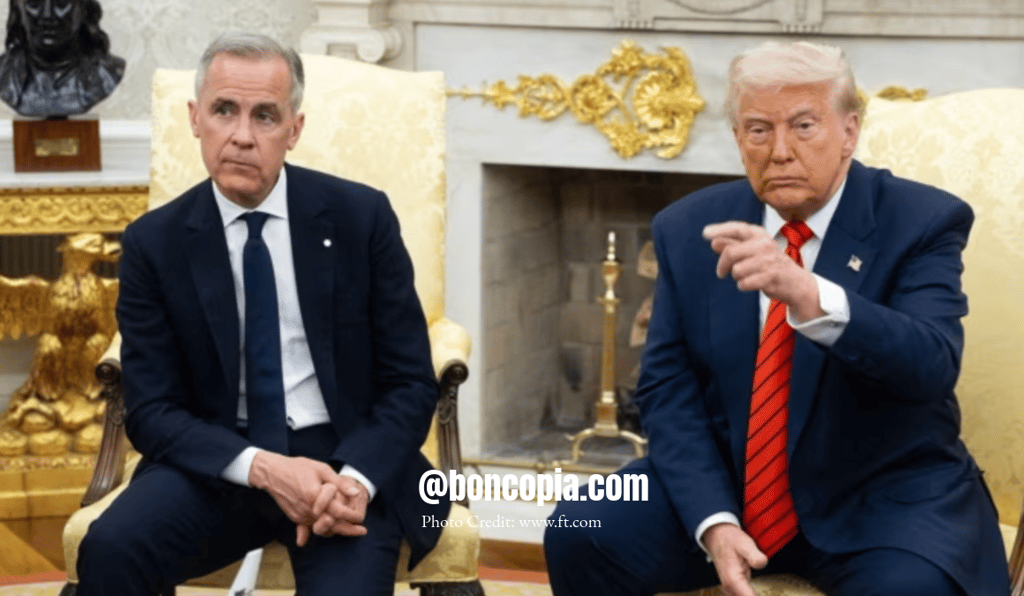High Stakes at the White House: Can Carney Stand Up to Trump?
5/7/20254 min read


High Stakes at the White House: Can Carney Stand Up to Trump?
Published on Boncopia.com | May 6, 2025
A Tense Meeting Looms
Canadian Prime Minister Mark Carney is heading to Washington on May 6, 2025, for a high-stakes meeting with U.S. President Donald Trump at the White House. The visit, announced by Carney on May 2, comes amid Trump’s escalating trade war and annexation threats against Canada. Fresh off a stunning election victory, Carney has vowed to fight for Canada’s interests—but can he navigate Trump’s unpredictable style? Let’s dive into the stakes, the backdrop, and what this meeting means for U.S.-Canada relations.
Carney’s Bold Stance
Carney, who became prime minister after Justin Trudeau’s resignation, has taken a hard line against the U.S. His Liberal Party’s comeback win on April 29, 2025, was seen as a direct rebuke of Trump’s policies, particularly his trade war and attacks on Canadian sovereignty. “Canadians elected a new government to stand up to President Trump and build a strong economy,” Carney declared in his first post-election remarks, as reported by The Guardian on April 30, 2025. He’s emphasized that the “old relationship” with the U.S.—one of increasing integration—is over, signaling a new era of Canadian assertiveness.
Carney has also leaned on Canada’s oldest allies, the UK and France, while distancing himself from the U.S. A May 3, 2025, Global News report noted his announcement that King Charles III, Canada’s head of state, will deliver a Speech from the Throne on May 27, outlining the government’s priorities when Parliament resumes. This symbolic move underscores Canada’s Commonwealth ties at a time of strained U.S. relations.
Trump’s Trade War and Threats
Trump has been unrelenting in his pressure on Canada. A May 6, 2025, Newsweek article reported Trump’s Truth Social post questioning why the U.S. subsidizes Canada by $200 billion annually while providing “free military protection.” His administration has imposed 25% tariffs on Canadian goods, as noted by The Independent on May 6, 2025, and he’s repeatedly threatened annexation, calling Canada a “51st state.” These actions have fueled outrage among Canadian voters, propelling Carney’s victory.
The stakes are high for this meeting. Trump has teased trade deals with multiple countries, including Canada, to avoid his tariffs, but no agreement has materialized. A J.P. Morgan Research update from May 2025 highlighted a one-month tariff reprieve for USMCA countries (Canada and Mexico) until April 2, but tensions persist. Carney has said Canada’s “close friendship with the U.S. has ended,” citing the decline of an 80-year period of American global leadership rooted in trust, per The Independent.
A Risky Visit?
Not everyone thinks Carney should make the trip. Robert Bothwell, a University of Toronto professor of Canadian history and international relations, told Global News on May 3, 2025, that Carney risks being insulted by Trump, who previously mocked Trudeau as “Governor Trudeau.” While Trump hasn’t trolled Carney yet, the meeting could turn sour—especially after Trump’s disastrous February 2025 meeting with Ukrainian President Volodymyr Zelensky, which ended in a public spat over minerals deals, as noted by Newsweek.
Carney, however, remains optimistic. “On Tuesday, I had a very constructive call with President Trump, and we agreed to meet next Tuesday in Washington,” he said on May 2, per The Independent. “My government will fight to get the best deal for Canada.” His goal is a comprehensive trade and security deal to reset U.S.-Canada relations, but he’s prepared for a tough fight, warning, “Do not expect white smoke out of that meeting.”
The Bigger Picture: A Shifting Global Order
This meeting isn’t just about trade—it’s about the future of U.S.-Canada relations and America’s global standing. A 2024 Pew Research Center report showed declining trust in the U.S., with only 67% of Japanese and 54% of Australians holding favorable views. Canada, a key U.S. ally, is now looking elsewhere—its recent trade deal with the UK, valued at $34.13 billion annually by 2040, signals a pivot, per Reuters on May 6, 2025. Meanwhile, China’s Belt and Road Initiative has invested $1 trillion globally since 2013, per the Council on Foreign Relations, filling gaps left by a retreating U.S.
For Canada, the stakes are economic and existential. The U.S. remains its largest trading partner—$582 billion in goods in 2023, per the U.S. Trade Representative—but Trump’s tariffs threaten jobs and growth. Carney’s visit is a chance to push back, but it’s also a gamble that could either mend ties or deepen the rift.
What’s at Stake for Both Leaders?
For Carney, this meeting tests his ability to stand up to Trump while securing a deal that protects Canadian interests. For Trump, it’s an opportunity to show he can negotiate without alienating a key ally—though his track record suggests otherwise. The outcome could shape North American trade for years, especially as global alliances shift and economic pressures mount.
Let’s Discuss
Do you think Carney’s visit to the White House is a smart move, or should he have stayed away as Bothwell suggested?
How worried are you about the impact of Trump’s tariffs on U.S.-Canada relations and the broader global economy?
Can Carney secure a deal that benefits Canada, or will Trump’s unpredictability derail the talks?
What does this meeting mean for America’s role as a global leader—can it regain trust with allies like Canada?
We’d love to hear your thoughts in the comments!
Word Count: 842
hello@boncopia.com
+13286036419
© 2025. All rights reserved.